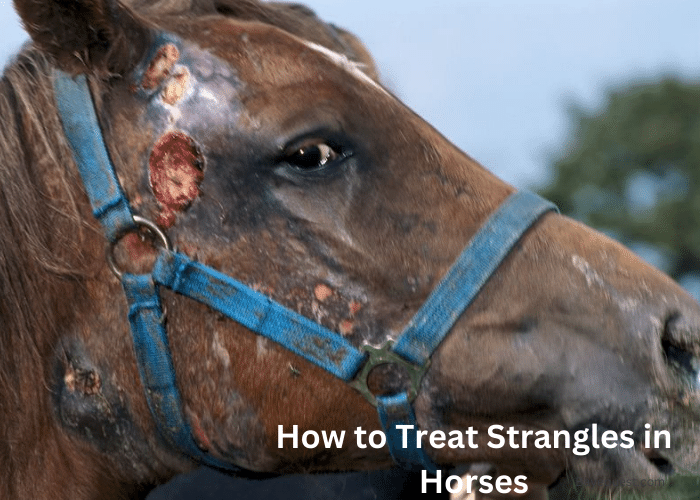Strangles in horses is a term that can send shivers down the spine of any horse owner. It’s a condition marked by alarming symptoms.
Yet, understanding and tackling this highly contagious infection is not just possible. It’s the responsibility of those who care deeply for these magnificent animals.
In this guide, “How to treat strangles in horses,” we’ll cover everything you need to know about strangles.
Let’s embark on this journey together, transforming fear into action and illness into wellness.
Quick Facts About Strangles Disease
Strangles in horses are a highly contagious disease characterized by fever, nasal discharge, and swollen lymph nodes with abscesses. To treat strangles, use hot packs to mature abscesses, then drain and flush them. In severe cases, antibiotics or hospitalization may be necessary. To prevent the spread, quarantine affected horses.
What is the Strangles in Horses? (Etiology of Strangles)
Strangles are caused by the bacterium Streptococcus equi subspecies equi (S. equi equi). This pathogen is highly infectious and adapted to horses, making it the leading cause of lymphadenitis in equines.
The bacteria target the upper respiratory tract, where they find the ideal conditions to multiply and spread.
The name “strangles” comes from this very symptom, as the swollen glands can literally strangle the horse’s airways.
What horses are at risk of infection?
Any horse can catch strangles, but young horses, typically those between 1 to 5 years old, are more susceptible.
Horses that travel often or live in large groups, like those in boarding facilities or training centers, face a higher risk. The stress of moving or being in new environments can also lower their immune defenses, making them more vulnerable.
Do strangles occur in other species?
Strangles mainly affects horses, donkeys, and mules. It’s rare in other species. The bacterium Streptococcus equi is highly adapted to equines.
This means, it’s specifically tailored to infect them. While there are similar bacteria that can cause disease in other animals, strangles are a concern primarily for those in the equine family.
How do strangles spread?
Strangles spreads through close contact with infected horses or with contaminated objects. This includes sharing water troughs, feed buckets, grooming tools, and even human hands or clothing that haven’t been cleaned after touching an infected horse.
The disease can also spread when an infected horse coughs or sneezes, releasing the bacteria into the air. Because it’s highly contagious, managing an outbreak requires strict biosecurity measures.
Pathogenesis of Strangles for Horses
The pathogenesis of strangles unfolds in stages after the S. equi equi bacteria enter the horse’s body. This is usually through the nostrils or mouth.
Here’s a step-by-step breakdown of the process:
Inhalation or ingestion. The initial contact occurs when a horse inhales aerosolized droplets or ingests material contaminated with the bacteria.
Colonization. After entering the respiratory tract, the bacteria attach to the mucosal surfaces and colonise. Their virulence factors include a hyaluronic acid capsule that evades immune detection and various proteins that facilitate adhesion and invasion.
Invasion and immune response. The bacteria then invade deeper tissues, activating the horse’s immune response. White blood cells are recruited to the site of infection. This results in the characteristic swelling of lymph nodes as they fill with pus and bacteria.
Abscess formation. The lymph nodes, particularly those in the throat latch area, become enlarged and may form abscesses. These abscesses can rupture, releasing large amounts of bacteria into the environment or into the nasal passages.
Systemic spread (Bastard strangles). In some cases, the bacteria can spread beyond the local infection site and cause abscesses in other parts of the body. This is a condition known as “bastard strangles.”
Resolution or chronic carrier state. Most horses will recover from strangles with appropriate care, but some may become chronic carriers of the bacteria.
What are the Clinical Signs of Equine Strangles?
The clinical signs of strangles in horses can vary from mild to severe, but there are several key indicators that appear when a horse is infected with the Streptococcus equi bacterium.
These signs include:
- Fever: Often the first sign, a horse’s temperature may rise above the normal range of 99.5°F to 101.5°F (37.5°C to 38.6°C).
- Nasal discharge. The nasal discharge may initially be clear, but it becomes thick, purulent (pus-like), and yellow as the disease progresses.
- Swollen lymph nodes. The lymph nodes around the jaw, throatlatch area, and under the ears can become swollen, firm, and painful.
- Abscess formation. The swollen lymph nodes may develop into abscesses that can burst.
- Cough. A dry, hacking cough may develop due to throat irritation and lymph node enlargement.
- Difficulty swallowing and breathing. Swelling of the lymph nodes and throat tissues can make it hard for the horse to swallow and breathe.
- Loss of appetite and depression. Affected horses may show a decreased interest in food and water due to the pain and discomfort of swallowing, along with general malaise.
- Stridor. The swelling can cause a noisy, raspy breathing sound known as stridor.
- Lethargy. Horses might appear lethargic or less active than usual.
- Eye discharge. Some horses may also exhibit a watery discharge from the eyes.
How is Strangles Diagnosed?
Diagnosing strangles is crucial for effective management and containment of the disease. The process involves a combination of clinical signs, laboratory tests, Guttural pouch endoscopy and sometimes, the history of exposure to known cases.
Here’s a detailed look at the diagnostic approach:
Observation of clinical signs
The initial step involves thoroughly examining the horse for common symptoms of strangles.
While these signs can suggest strangles, definitive diagnosis requires laboratory confirmation.
Laboratory tests
Laboratory tests are essential for confirming the presence of Streptococcus equi subspecies equi. The most commonly used diagnostic tests include:
Bacterial culture. This test involves taking a sample from the nasal discharge, abscess material, or a swab from the nasopharynx. The sample is then cultured in a laboratory to see if the specific bacteria grow.
PCR Tests. Polymerase Chain Reaction is a rapid and sensitive method that detects the DNA of the S. equi bacterium in samples. This test can quickly confirm the presence of the bacteria, often within hours to a few days.
Serology. This test measures antibodies in the blood against the S. equi bacterium. It can help determine whether a horse has been exposed to strangles recently or in the past.
Guttural pouch endoscopy
This is a valuable diagnostic tool for investigating upper respiratory tract diseases.
The endoscope is a long, flexible tube with a light and camera at its tip. It’s inserted through the nostril and guided into the guttural pouches. This allows the veterinarian to inspect the inside of these structures in real-time visually.
How to Treat Strangles in Horses
Treating a horse with strangles involves a combination of supportive care and, sometimes, medical intervention. This depends on the infection’s severity and the horse’s specific needs.
Here’s a comprehensive approach to managing and treating strangles:
Supportive care
Maintain excellent hygiene practices for both the horse and the environment. This includes regularly cleaning and disinfecting stalls and equipment and avoiding shared water sources or feed containers.
Ensure the horse can access fresh water and easy-to-eat, high-quality food. Swollen lymph nodes may make swallowing difficult, so soft or soaked feed can help.
Regularly monitor the horse’s temperature, appetite, and general demeanor. Check the size and progression of any abscesses.
Managing abscesses
Applying warm compresses to swollen lymph nodes can help encourage abscesses to mature and rupture, providing relief.
Sometimes, a veterinarian may need to lance (open) an abscess to promote drainage. Keep the area clean once an abscess has ruptured, naturally or through lancing.
Antibiotics
The use of antibiotics in strangles cases is controversial and should be based on veterinary advice. Antibiotics can be beneficial in certain situations.
These include compromised immune systems, those at risk of bastard strangles, or in the very early stages of infection.
However, their use can sometimes hinder the body’s ability to develop immunity.
If prescribed, the choice of antibiotic will depend on the veterinarian’s assessment and may include penicillin or another suitable antibiotic.
Pain management
Nonsteroidal anti-inflammatory drugs (NSAIDs) like phenylbutazone or flunixin meglumine may reduce fever, pain, and swelling associated with the infection.
What is the Prognosis of Strangles?
The prognosis for horses with strangles is generally favorable. Most affected horses fully recover, especially when the disease is diagnosed early and managed well.
Young and healthy horses bounce back more quickly, but complications can arise. These include bastard strangles or purpura hemorrhagic and guttural pouches infection.
Horses with weakened immune systems may face a harder recovery. Some horses become carriers after infection, shedding the bacteria without showing symptoms.
Identifying and managing these carriers is important to prevent further outbreaks. Overall, with vigilant care and monitoring, the outlook for horses with strangles is positive.
Prevention of Horse Disease Strangles
Here are key strategies for preventing strangles:
Vaccination
Vaccination is an effective preventive measure, especially for horses at high risk of exposure to strangles.
Ensure that all vaccinations are kept up-to-date according to the recommended schedule.
Also, you need to be aware that vaccines can reduce the risk of infection and the severity of the disease, but they do not guarantee complete protection against strangles.
Read also: What vaccines do horses need?
Biosecurity measures
Quarantine new arrivals. Isolate new or returning horses for at least 2-3 weeks to monitor for signs of strangles before introducing them to the herd.
Isolate sick horses. Isolate any horse showing symptoms of strangles from the rest of the herd.
Limit horse-to-horse contact. During outbreaks, avoid activities that involve close contact between horses.
Monitor health. Regularly monitor horses for signs of strangles and implement a plan for immediate action if symptoms are detected.
Disinfection and Hygiene
Feed and water hygiene. Avoid communal feeding and watering practices that can facilitate the spread of disease. Use individual feed buckets and water troughs where possible.
Travel precautions. When travelling, be cautious about exposing your horses to unfamiliar horses. Use your own feeding and watering equipment, and avoid using communal facilities.
Educate your team. Ensure that everyone involved in caring for your horses, including is aware of the signs of strangles.
Environmental management
Manage pastures. Regularly rest and rotate pastures to reduce the buildup of pathogens in the environment.
Control wildlife and rodent populations. Wildlife and rodents can carry and spread diseases, including strangles. Implement control measures to reduce their presence in horse stabling and feeding areas.
How Serious is Strangles?
Strangles is a serious infectious disease in horses due to its high contagion level. It has the potential for significant health impacts on affected horses and can disrupt equine facilities.
While most horses recover with proper management, the disease’s nature and possible complications underscore its seriousness.
Control of Strangles
Controlling strangles needs careful steps. First, vaccinate horses to make them less likely to get sick.
Next, keep new or returning horses away from others for at least 2-3 weeks. This helps catch any signs of strangles early.
Also, clean hands, tools, and horse areas well to stop germs from spreading. If a horse shows signs of being sick, keep it away from others immediately.
Always ask a vet for help with sick horses. They can tell you if it’s strangles and what treatment is best. Using separate feeding and drinking tools for each horse also helps keep the disease from spreading.
By doing all these things, we can protect horses from strangles.
Conclusion
It’s clear that safeguarding our horses boils down to proactive measures and teamwork. Vaccination, rigorous cleanliness, and eagle-eyed vigilance are our main defenses.
By isolating any horse that shows symptoms and consulting vets promptly, we’re on the right path. Each step we take towards prevention not only protects individual horses but also fortifies our equine community against this disease.
So, let’s commit to these practices, ensuring our stables remain sanctuaries of health. Together, in unity and with dedication, we can shield our cherished companions from strangles.
Here’s to healthy horses and brighter days ahead!








